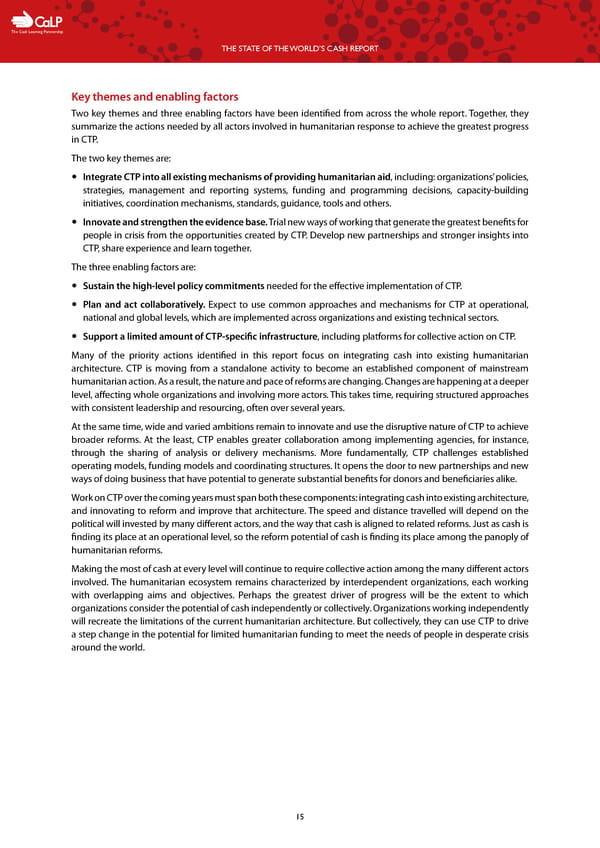C The Cash Learning Partnership THE STATE OF THE WORLD’S CASH REPORT Key themes and enabling factors Two key themes and three enabling factors have been identified from across the whole report. Together, they summarize the actions needed by all actors involved in humanitarian response to achieve the greatest progress in CTP. The two key themes are: — Integrate CTP into all existing mechanisms of providing humanitarian aid, including: organizations’ policies, strategies, management and reporting systems, funding and programming decisions, capacity-building initiatives, coordination mechanisms, standards, guidance, tools and others. — Innovate and strengthen the evidence base. Trial new ways of working that generate the greatest benefits for people in crisis from the opportunities created by CTP. Develop new partnerships and stronger insights into CTP, share experience and learn together. The three enabling factors are: — Sustain the high-level policy commitments needed for the effective implementation of CTP. — Plan and act collaboratively. Expect to use common approaches and mechanisms for CTP at operational, national and global levels, which are implemented across organizations and existing technical sectors. — Support a limited amount of CTP-specific infrastructure, including platforms for collective action on CTP. Many of the priority actions identified in this report focus on integrating cash into existing humanitarian architecture. CTP is moving from a standalone activity to become an established component of mainstream humanitarian action. As a result, the nature and pace of reforms are changing. Changes are happening at a deeper level, affecting whole organizations and involving more actors. This takes time, requiring structured approaches with consistent leadership and resourcing, often over several years. At the same time, wide and varied ambitions remain to innovate and use the disruptive nature of CTP to achieve broader reforms. At the least, CTP enables greater collaboration among implementing agencies, for instance, through the sharing of analysis or delivery mechanisms. More fundamentally, CTP challenges established operating models, funding models and coordinating structures. It opens the door to new partnerships and new ways of doing business that have potential to generate substantial benefits for donors and beneficiaries alike. Work on CTP over the coming years must span both these components: integrating cash into existing architecture, and innovating to reform and improve that architecture. The speed and distance travelled will depend on the political will invested by many different actors, and the way that cash is aligned to related reforms. Just as cash is finding its place at an operational level, so the reform potential of cash is finding its place among the panoply of humanitarian reforms. Making the most of cash at every level will continue to require collective action among the many different actors involved. The humanitarian ecosystem remains characterized by interdependent organizations, each working with overlapping aims and objectives. Perhaps the greatest driver of progress will be the extent to which organizations consider the potential of cash independently or collectively. Organizations working independently will recreate the limitations of the current humanitarian architecture. But collectively, they can use CTP to drive a step change in the potential for limited humanitarian funding to meet the needs of people in desperate crisis around the world. 15
 The State of the World's Cash | Full Report Page 16 Page 18
The State of the World's Cash | Full Report Page 16 Page 18